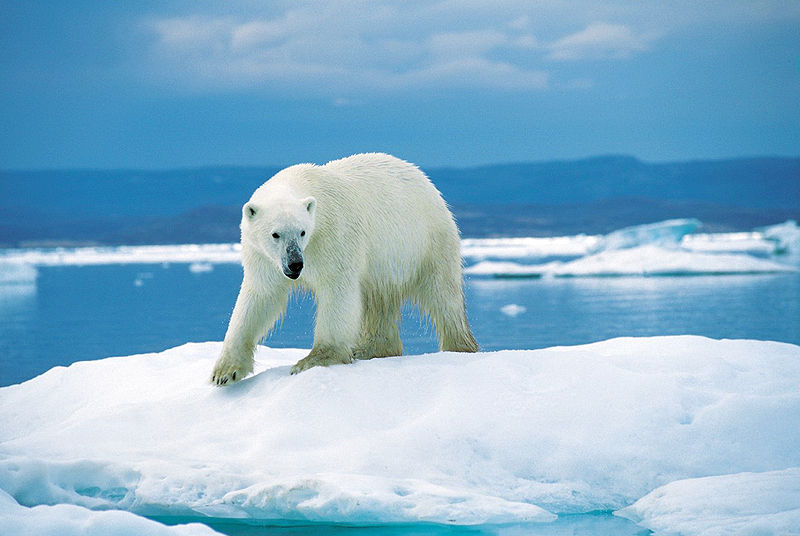Are Polar Bears Really Endangered?
“Glib contrarianism” in environmental journalism

(Wikimedia Commons/Ansgar Walk)
The news web site Slate is known for its counterintuitive articles – so much so, that the term “slatepitch” has been coined. But sometimes trying to write a counterintuitive article leads you to write something, well, just wrong.
Today, Slate ran an article about “Five Species You Thought Were Endangered That Really Aren’t (Including the Polar Bear).” Some of the examples here seem right to me: Praying mantises are not in trouble (I didn’t even know that apparently there is a rumor to the effect that they are endangered and legally protected.). Humpback whales really have bounced back, but the author rightly notes that other whales (such as right whales) are still on the edge of extinction.
But it is the polar bear example that probably sold the “slatepitch” to the editors of Slate. Why praying mantises aren’t really endangered probably doesn’t drive a lot of clicks and eyeballs – but polar bears? They always grab attention.
Here’s what the author wrote:
An iconic photograph of a polar bear clinging to a chunk of melting Arctic ice has driven home the idea that polar bears are going extinct due to global warming. But the science doesn’t necessarily back this up. There are 19 subpopulations of polar bears and eight of them are in decline. Warmer temperatures and shorter-lived ice mean that fewer polar bears can be supported than in the recent past, but there are more than enough to ensure the survival of the species.
There are currently about 25,000 polar bears worldwide. In the 1970s the species numbered somewhere between 5,000 and 10,000; their recovery since then is owed in part to a 1975 treaty regulating the hunting of polar bears. The International Union for Conservation of Nature predicts that numbers will decrease by 30 percent or more by the year 2053, mostly due to climate change. That is a dramatic loss, but it will still put polar bear numbers ahead of where they were.
DNA studies have shown that polar bears have existed as a species for about 600,000 years. They have lived through many warming and cooling periods in Earth’s history, and they didn’t become extinct during times when ice disappeared. Polar bears also interbred with brown bears during those phases when they had to seek out food on land rather than the seals that they now prefer. Neither hybridization nor global warming are likely to wipe out the polar bear anytime soon.
But if you check that IUCN link that the author helpfully provided, it actually says that “[i]f climatic trends continue polar bears may become extirpated from most of their range within 100 years.” (The full quote is at the end of this post, in case you want to see the full context.)
So what did the author do? He (a) highlighted that there are a lot of polar bears right now; (b) used a shorter-term reference point for future trends; and (c) ignored longer-term future trend information that would indicate that the polar bear is in serious trouble. In other words, he committed the common fallacy in conservation work of focusing more on total numbers and not enough on trends. Even worse, the author argued that the polar bears are likely to adapt to changing conditions when the IUCN report (while somewhat confused on this point) overall appears to state that adaptation is unlikely or difficult.
Now there are two possible mitigating factors for the author here. First, as the full IUCN quote makes clear, just because the polar bear loses most of its range does not mean that it necessarily loses most of its population. The IUCN notes that if the species were going extinct in the next 100 years, it would lose at least 50% of its population in 45 years, but the “more realistic evaluation” is a loss of at least 30% in 45 years (that’s the number the author quoted). That’s cold comfort for the polar bear, I think (pun intended!). After all, populations will continue to decline after that 45 year period, so numbers will drop even further (and this belies the author’s statement that implies that the polar bear will be better off even in the future than it was in the 1970s when it was under threat from hunting). The lower percentage decline of 30% might just mean that extinction will occur more than 100 years from now (say in 2150 rather than 2100).
Second, you might wonder if we can make predictions that far in the future. As the author notes, the polar bear might adapt; threats might change, etc. So who knows what could happen in 100 years, and whether the trend lines will continue that far in the future? The problem with that line of argument is that climate change is a long-term process. Once carbon dioxide is in the atmosphere, it stays up there for a long, long time; and once the oceans warm up, they will stay warm. In other words, this is not like the threat that hunting can pose to species, where if it is reversed (some species at least) can bounce back quickly – as with the polar bear bouncing back from hunting in the 1970s. The trend lines for the climate in the Arctic are pretty strong, and pretty unlikely to be changed, even 100 years from now. (Unless we geoengineer the climate, but that’s a separate issue!)
So this is another example of a phenomenon that is all too common in environmental journalism – what I have called “glib contrarianism.” Take the uncertainty and ambiguity that is ever present in environmental science and policy, spin it in a way that highlights a counterintuitive narrative and gets you a lot of attention, and send out an article that will lead a bunch of people to say: Those polar bears, they aren’t in trouble! (As the author says: “Neither hybridization nor global warming are likely to wipe out the polar bear anytime soon.”) The author could have discussed the uncertainties present about (a) the adaptability of the polar bear to future conditions that might be unprecedented in recent geologic history; (b) the level of population decline and range loss. Those uncertainties, however, would have made the story a much less effective slatepitch. So they didn’t make it into the piece. That’s just wrong.
Here’s the full relevant quote from the IUCN website:
Polar bears rely almost entirely on the marine sea ice environment for their survival so that large scale changes in their habitat will impact the population (Derocher et al. 2004). Global climate change poses a substantial threat to the habitat of polar bears. Recent modeling of the trends for sea ice extent, thickness and timing of coverage predicts dramatic reductions in sea ice coverage over the next 50-100 years (Hassol 2004). Sea ice has declined considerably over the past half century. Additional declines of roughly 10-50% of annual sea ice are predicted by 2100. The summer sea ice is projected to decrease by 50-100% during the same period. In addition the quality of the remaining ice will decline. This change may also have a negative effect on the population size (Derocher et al. 2004). The effects of sea ice change are likely to show large differences and variability by geographic location and periods of time, although the long term trends clearly reveal substantial global reductions of the extent of ice coverage in the Arctic and the annual time frames when ice is present.
While all bear species have shown adaptability in coping with their surroundings and environment, polar bears are highly specialized for life in the Arctic marine environment. Polar bears exhibit low reproductive rates with long generational spans. These factors make facultative adaptation by polar bears to significantly reduced ice coverage scenarios unlikely. Polar bears did adapt to warmer climate periods of the past. Due to their long generation time and the current greater speed of global warming, it seems unlikely that polar bear will be able to adapt to the current warming trend in the Arctic. If climatic trends continue polar bears may become extirpated from most of their range within 100 years.
There is little doubt that polar bears will have a lesser AOO, EOO and habitat quality in the future. However, no direct relation exists between these measures and the abundance of polar bears. While some have speculated that polar bears might become extinct within 100 years from now, which would indicate a population decrease of >50% in 45 years based on a precautionary approach due to data uncertainty. A more realistic evaluation of the risk involved in the assessment makes it fair to suspect population reduction of >30%.
Other population stress factors that may also operate to impact recruitment or survival include toxic contaminants, shipping, recreational viewing, oil and gas exploration and development. In addition to this comes a potential risk of over-harvest due to increased quotas, excessive quotas or no quotas in Canada and Greenland and poaching in Russia.
Reader Comments
2 Replies to “Are Polar Bears Really Endangered?”
Comments are closed.







Thanks for calling Slate out on this. There’s a host of species in this same position. I like the example of the creatures living around the streams of Glacier National Park; many are doing perfectly well, and some are even thriving on the recent influx of glacial meltwater. But as the name may suggest, meltwater is unsustainable, and in twenty years, as the glaciers disappear, the stream will become a trickle, and then nothing, and then there will probably be some fast extinctions–there are some isolated, unique species living there that won’t be able to relocate on such a quick timeline.
Granted, these species lack the polar bear charm, but they’re tied to the ecosystem. And there are almost certainly some other big fluffy critters in the same situation; living it up now, but on their way out all the same.
There are other environmental problems. A large accumulation of trash from the tsunami in Japan is floating in the Pacific ocean and drifting towards the coast of California. Long stretches of beaches will soon become trash dumps. Check out the photo gallery to see what’s in store. This is serious.
http://www.mirror.co.uk/news/world-news/floating-island-rubbish-three-times-2678207